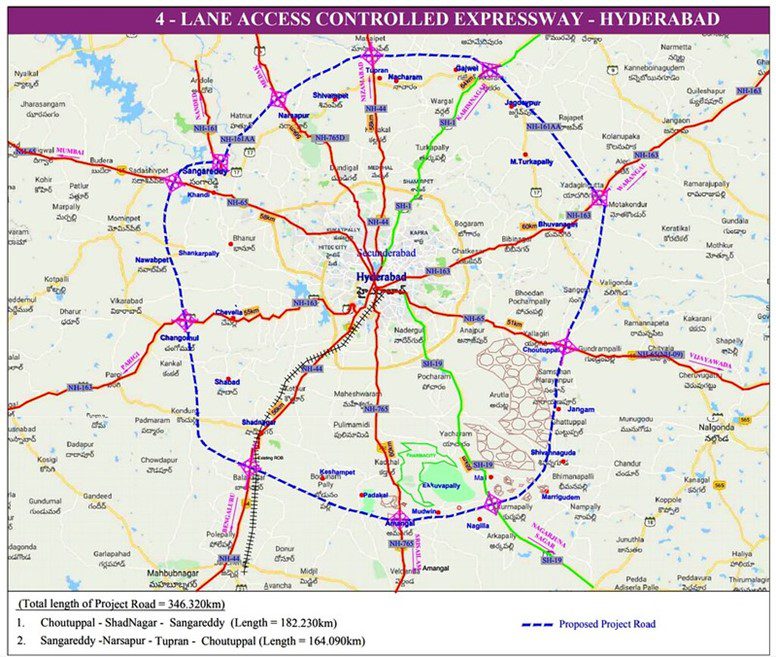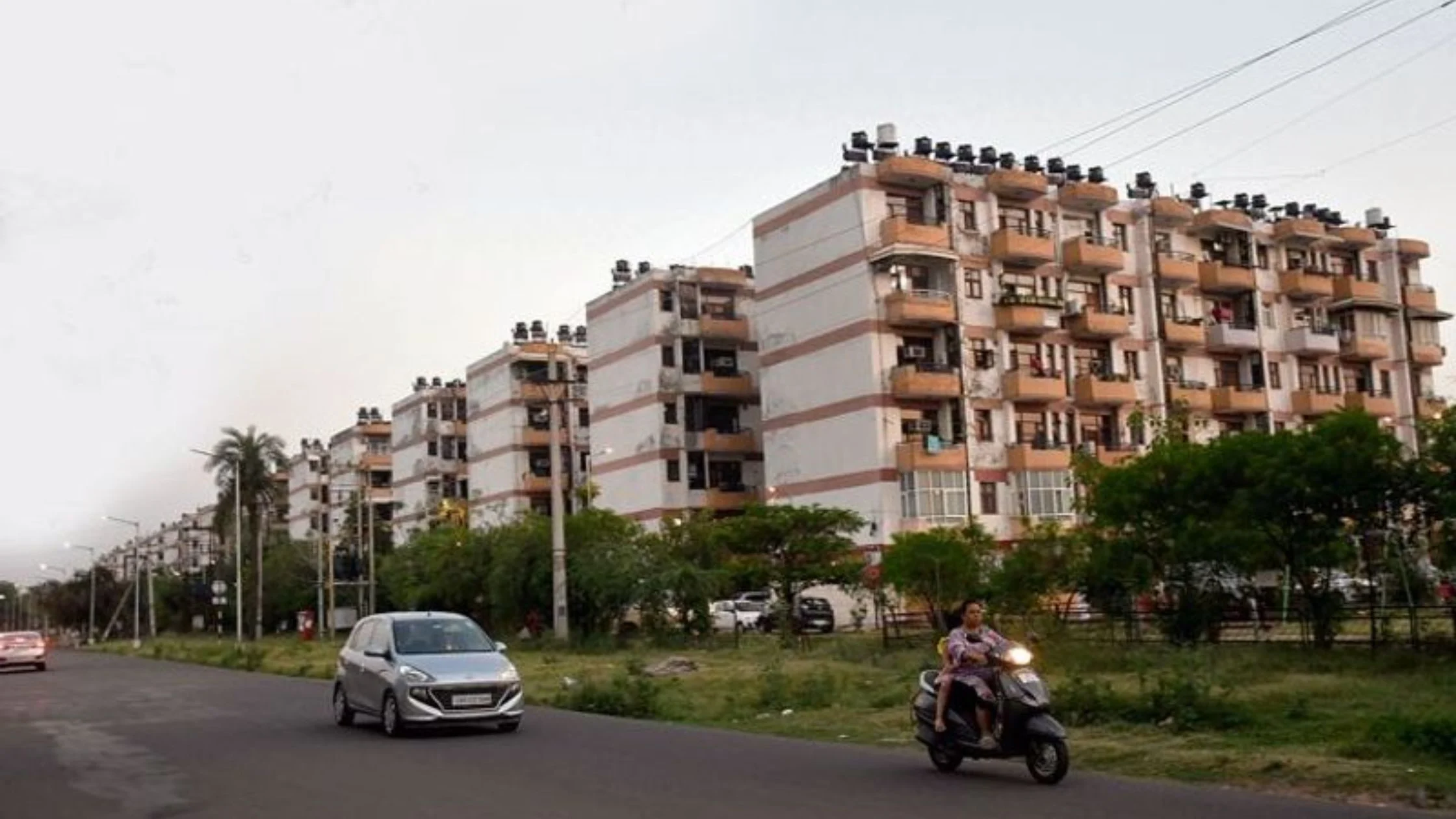Table of Content
The Regional Ring Road Hyderabad (RRR Hyderabad) is set to be one of India’s largest infrastructure projects, aimed at enhancing connectivity across Telangana and beyond. Developed under phase 1 of the Bharatmala Pariyojana and spearheaded by the National Highways Authority of India (NHAI), this four-lane semi-greenfield expressway is designed to connect key districts, towns, and highways while driving significant real estate growth.
In this article, we delve into the RRR Hyderabad’s route map, key project details, toll and cost information, and its broader impact on the real estate market.
Project Overview
The Regional Ring Road Hyderabad is a 340-km access-controlled expressway that forms a crucial part of Telangana’s infrastructure development. With an estimated project cost of around Rs 17,000 crore, the RRR is being constructed in two sections:
- Northern Section: 164 km
- Southern Section: 182 km
The expressway is expected to connect as many as 17 national and state highways, 20 towns, and 300 districts. Key localities along the route include Sangareddy, Toopran, Choutuppal, Amangal, and Shankarpally. The project is designed to improve traffic flow, reduce congestion, and spur economic development along its corridor.
Also Read: Hyderabad Metro Phase 2: Shaping a Modern, Connected City
Quick Facts: Regional Ring Road Hyderabad
|
Attribute |
Details |
|
Length |
340 km |
|
Status |
Under-construction |
|
Sections |
Northern – 164 km; Southern – 182 km |
|
Estimated Cost |
Rs 17,000 crore |
|
Lanes |
Four |
|
Owner |
National Highways Authority of India (NHAI) |
|
Managed by |
Greater Hyderabad Municipal Corporation, Hyderabad Metropolitan Region, Hyderabad Urban Development Authority |
Route Map and Connectivity
The RRR Hyderabad will traverse a strategic route that links key economic and residential centers. The expressway will serve as an alternative route, bypassing congested urban areas and connecting vital corridors. Notable features of the route include:
- Key Localities:
The expressway will pass through crucial areas such as Sangareddy, Toopran, Choutuppal, Amangal, and Shankarpally, ensuring enhanced connectivity between urban and rural regions. - Highway Connections:
The RRR Hyderabad will integrate with several national highways (e.g., NH 65, NH 44, NH 163, NH 765) and state highways, facilitating smooth travel and logistics. - Interchanges:
Multiple interchanges (such as the Hyderabad-Mumbai National Highway Interchange and Sangareddy-Nanded Road interchange) are planned to provide easy access to the expressway from various arterial roads.

Cost Details
The construction of the RRR Hyderabad will be financed through a collaborative funding model involving both state and central governments. The cost-sharing arrangement entails:
- Northern Section Cost: Approximately Rs 9,500 crore
- Southern Section Cost: Approximately Rs 6,480 crore
| Northern part (158 kms) | Southern part (182 kms) |
| Sangareddy | Choutuppal |
| Narsapur | Ibrahimpatnam |
| Toopran | Kandukur |
| Gajwel | Amangal |
| Yadadri | Chevella |
| Pragnapur | Shankarpally |
| Bhongir | Sangareddy |
| Choutuppal |
Also Read: Samruddhi Mahamarg: Route Map, Status, and Real Estate Impact
Current Status and Timeline
The project’s progress is well underway:
- Land Acquisition:
The state government has completed nearly 94% of the land acquisition for the northern corridor, while the process is in progress for the southern section. - Regulatory Approvals:
The northern section has already received forest clearance and other necessary approvals. - Bidding Process:
Bids for the four-lane access-controlled highway on the northern side of Hyderabad were invited in December 2024, with the submission deadline on February 14, 2025, and bid opening scheduled for February 17, 2025. - Future Integration:
Plans are also in place to develop radial roads in the proposed Future City, linking the Outer Ring Road (ORR) and RRR, as well as a Regional Ring Railway to further enhance connectivity.
Timeline Overview:
|
Year |
Milestone |
|
2017 |
Telangana government proposes the RRR project |
|
2018 |
Union Ministry sanctions Rs 5,500 crore; in-principle approval given |
|
2019 |
DPR demanded following concerns over financial viability |
|
2021 |
Centre approves the project; NHAI invites tenders for the northern section |
|
2022 |
Land survey initiated for Yadadri Bhuvanagiri district |
|
2024 |
Telangana CM advises fast-tracking; bids invited for the 161-km northern corridor |
|
2025 |
Bid submission deadline: February 14; Bid opening: February 17 |
Real Estate Impact
The Regional Ring Road Hyderabad is expected to have a transformative effect on the real estate market in and around Hyderabad. Here’s how:
Boost in Property Values
- Increased Connectivity:
Improved road links will boost property demand in areas previously hindered by poor connectivity. Localities along the RRR corridor are anticipated to experience property value increases of 10-20%. - Attracting New Developments:
Enhanced infrastructure will spur the development of satellite townships, industrial clusters, IT centers, and commercial projects, thereby stimulating overall market growth.
Impact on Rental Markets
- Rising Rental Rates:
Improved access to key regions and economic hubs is expected to lead to higher rental rates. For example, property rates near the RRR show varied growth:
|
Location |
Property Prices (Rs/sq ft) |
Rental Rates (Rs/month) |
|
Sangareddy |
Rs 13,071 |
Rs 10,000 |
|
Begumpet |
Rs 10,855 |
Rs 25,000 |
|
Ibrahimpatnam |
Rs 5,000 |
Rs 8,000 |
|
Shankarpally |
Rs 5,847 |
Rs 45,000 |
|
Rangareddy |
Rs 7,094 |
Rs 18,000 |
Economic and Urban Growth
- Industrial and Commercial Boom:
The RRR is set to drive growth in IT clusters, logistics parks, and industrial zones, making it a catalyst for economic expansion. - New Urban Nodes:
As connectivity improves, new satellite cities and urban nodes are expected to emerge, further enhancing the region’s real estate potential.
Conclusion
The Regional Ring Road Hyderabad is a landmark project with the potential to revolutionize transportation and spur substantial real estate growth in the region. With a robust route map connecting key localities, competitive toll structures, and significant government backing, the RRR Hyderabad will pave the way for new urban developments and property value appreciation.
For homebuyers, investors, and developers, this mega infrastructure project presents an exciting opportunity to capitalize on improved connectivity and enhanced market potential. As the project progresses and new urban nodes emerge, the real estate landscape around Hyderabad is set to transform, offering robust growth prospects for years to come.
Stay tuned for more updates on the Regional Ring Road Hyderabad as it continues to shape the future of urban development and real estate in Telangana and beyond.
Also Read: TVS Emerald Acquires 10-Acre Bengaluru Land Parcel, Aims for Rs 1,600 Crore in Revenue

_1740563207.webp)

_1765522271.webp)

_1765444636.webp)

Ans 1. RRR Hyderabad is a 340 km access-controlled expressway designed to enhance connectivity across Telangana by linking key districts and integrating with highways like NH 65, NH 44, NH 163, and NH 765.
Ans 2. The expressway is divided into the Northern Section (164 km) and the Southern Section (182 km), each designed to efficiently manage traffic and improve regional connectivity.
Ans 3. The route passes through significant areas such as Sangareddy, Toopran, Choutuppal, Amangal, and Shankarpally, facilitating easier access to both urban and rural regions.
Ans 4. Notable interchanges include the Hyderabad-Mumbai National Highway Interchange and the Sangareddy-Nanded Road interchange, ensuring smooth transitions between arterial roads and the expressway.
Ans 5. The expressway connects with several national and state highways, providing alternate routes that bypass congested urban areas and linking major corridors for improved logistics.
Ans 6. The total project cost is estimated at around Rs 17,000 crore, reflecting a significant investment in modern infrastructure and sustainable road design.
Ans 7. Toll plazas will be strategically placed along the expressway, with a pricing strategy designed to recover costs while ensuring affordability for daily commuters and logistics operators.
Ans 8. As of early 2025, land acquisition and regulatory approvals for the northern section are nearly complete, with major construction expected to begin soon and the entire project set to be operational by 2027–2028.
Ans 9. Enhanced connectivity from RRR is expected to boost property values by 10-20% in adjacent areas and attract new residential, commercial, and retail developments along its route.
Ans 10. The project is poised to stimulate regional economic growth by reducing travel times, lowering logistics costs, and promoting urban renewal and investment in emerging urban nodes.